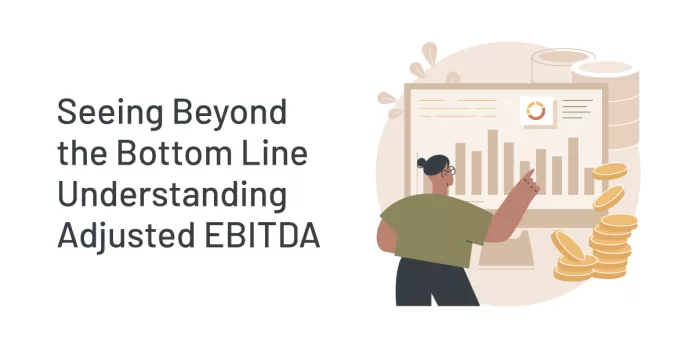While net income is a standard measure of a company’s financial health, it can be influenced by various non-operating factors like taxes, interest expenses, and depreciation. This is where EBITDA and Adjusted EBITDA (Earnings Before Interest, Taxes, Depreciation, and Amortization) comes in. While EBITDA offers a snapshot of a company’s operating performance by excluding certain expenses, Adjusted EBITDA takes it a step further by removing exceptional or one-time items. Understanding the difference between these metrics is crucial for stakeholders to make informed decisions and accurately evaluate a company’s financial situation.
Read: All you Need to Know About EBITDA
Explaining Adjusted EBITDA
Adjusted EBITDA builds upon the foundation of EBITDA, aiming to provide a clearer representation of a company’s underlying profitability. While EBITDA excludes interest, taxes, depreciation, and amortization, Adjusted EBITDA further adjusts for non-recurring or one-time expenses that are not part of a company’s regular operations. These adjustments offer a more accurate assessment of a company’s ongoing operational performance, free from the distortions caused by exceptional events.
Difference between Adj EBITDA and EBITDA
The key distinction between Adjusted EBITDA and traditional EBITDA lies in the adjustments made to the latter. While EBITDA excludes interest, taxes, depreciation, and amortization, Adjusted EBITDA goes beyond by removing additional non-recurring expenses. This refinement provides stakeholders with a clearer view of a company’s core earnings, enabling better-informed decisions and comparisons across industries.
How and When Companies Use Adjusted EBITDA
Companies often utilize Adjusted EBITDA to present a more favourable view of their financial performance, particularly in situations where reported earnings may be impacted by one-time events. Adjusted EBITDA finds relevance in evaluating companies undergoing significant changes or facing irregular events, offering insights into their true operational performance and profitability trends.
Legitimacy of Adjusted EBITDA
While Adjusted EBITDA serves as a valuable tool in financial analysis, questions arise regarding its legitimacy. Critics argue that companies may misuse Adjusted EBITDA to mask poor performance or inflate earnings artificially. However, when used judiciously and accompanied by transparent disclosures, Adjusted EBITDA can offer valuable insights into a company’s financial health and operational strength.
Zomato Ltd.’s Adjusted EBITDA: A Case Study
Zomato Ltd., a leading Indian online food delivery and restaurant aggregator company, utilizes Adjusted EBITDA as a key financial metric to assess its core operating performance. This example delves into how Zomato calculates and leverages Adjusted EBITDA
Assume that the company reveals a revenue of Rs 4,200 Crore. After deducting expenses, excluding taxes, interest, depreciation, and amortization, amounting to Rs 3,800 Crore, the company achieves an EBITDA of Rs 400 Crore.
However, these results are further adjusted to reflect the impact of exceptional items. Notably, Zomato incurred legal settlement costs amounting to Rs 120 Crore, representing a one-time expense. To arrive at the Adjusted EBITDA, this expense is added back to the EBITDA figure, resulting in a total of Rs 520 Crore.
Conversely, the company also gained Rs 80 Crore from the sale of investments, another one-time event.
This gain is subtracted from the adjusted EBITDA, leading to a final Adjusted EBITDA of Rs 440 Crore. This calculation process demonstrates how Adjusted EBITDA provides a clearer picture of Zomato’s underlying operational performance by excluding the impact of one-time events like legal settlements and investment gains.
When Adjusted EBITDA is Really Useful
Adjusted EBITDA proves particularly useful when assessing companies navigating transformative events or facing irregular expenses. By excluding one-time items and focusing on core operational performance, Adjusted EBITDA enables stakeholders to identify sustainable trends and assess a company’s long-term viability more accurately.
Adjusted EBITDA is crucial for valuing companies during mergers, evaluating growth firms, and spotting industry trends. It assesses ongoing cash flow potential, excluding one-time costs, aiding in accurate valuation. Startups’ profitability and industry trends can be analysed effectively using Adjusted EBITDA.
Limitations to Consider
Quality of earnings hinges on the integrity of adjustments made to EBITDA, which can differ based on industry standards and a company’s discretion. Investors must carefully examine these adjustments to confirm their legitimacy and alignment with actual operational performance. This underscores the importance of assessing the reliability and accuracy of a company’s reported earnings.
Conclusion
In conclusion, Adjusted EBITDA serves as a valuable tool for stakeholders, offering a clearer view of a company’s underlying profitability by excluding one-time events. While it aids in accurate valuation, its legitimacy relies on transparent disclosures and judicious use. Zomato Ltd.’s case study exemplifies how Adjusted EBITDA enhances understanding of operational performance, guiding informed decision-making. However, investors must remain vigilant of adjustments’ integrity and align them with actual operational performance to derive meaningful insights. Despite its limitations, Adjusted EBITDA remains a vital metric, providing valuable insights into a company’s financial health and operational strength.


